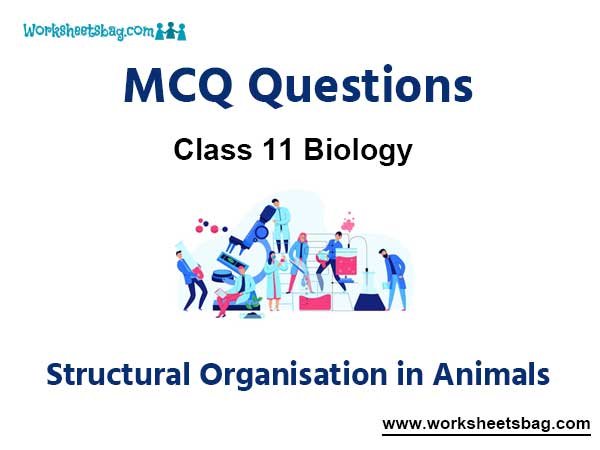Please refer to Structural Organisation in Animals MCQ Questions Class 11 Biology below. These MCQ questions for Class 11 Biology with answers have been designed as per the latest NCERT, CBSE books, and syllabus issued for the current academic year. These objective questions for Structural Organisation in Animals will help you to prepare for the exams and get more marks.
Structural Organisation in Animals MCQ Questions Class 11 Biology
Please see solved MCQ Questions for Structural Organisation in Animals in Class 11 Biology. All questions and answers have been prepared by expert faculty of standard 11 based on the latest examination guidelines.
MCQ Questions Class 11 Biology Structural Organisation in Animals
Question- Which of the follwing statement(s) is/are correct ?
(i) Cockroaches are brown or black bodied animals that are included in class insecta of phylum arthropoda.
(ii) Males bear a pair of short, thread like anal styles which are absent in females.
(iii) Heart of cockroach consists of elongated muscular tube lying along mid dorsal line of thorax and abdomen.
(iv) The nymph grows by moulting about 13 times to reach the adult form.
(a) Only (i)
(b) Both (ii) and (iii)
(c) Both (i) and (ii)
(d) All of the above
Answer
C
Question- Which of the following animal’s sensory system does not has eyes but does possess light and touch sensitive organs (receptor cells) to distinguish the light intensities and to feel the vibrations in the ground?
(a) Frog
(b) Snake
(c) Earthworm
(d) Cockroach
Answer
C
Question- Match column-I (type of epithelium) with column-II (Description) and choose the correct option.
Column-I Column-II
(Types of epithelium) (Description)
A. Squamous I. It is composed of a epithelium single-layer of cube-like cells
B. Cuboidal II. Having cilia on their free epithelium surface
C. Columnar III. It is composed of a single epithelium layer of tall and slender cells
D. Ciliated IV. It is made up of a single thin epithelium layer of flattened cells with
irregular boundaries
(a) A – IV; B – I; C – III; D – II
(b) A – I; B – IV; C – III; D – II
(c) A – IV; B – I; C – II; D – III
(d) A – IV; B – III; C – I; D – II
Answer
B
Question- Outer covering of cartilage is called
(a) perichondrium
(b) periosteum
(c) endosternum
(d) peritoneum
Answer
A
Question- Nervous tissue cells that play several supporting roles but do not transmit impulses are called
(a) glial cells
(b) dendrites
(c) nerve cells
(d) neurons
Answer
A
Question- Sharpey’s perforating fibres are related with
(a) heart contraction
(b) muscle relaxation
(c) fixing of teeth
(d) none of these
Answer
C
Question- The type of epithelial cells which line the inner surface of fallopian tubes, bronchioles and small bronchi are known as
(a) squamous epithelium
(b) columnar epithelium
(c) ciliated epithelium
(d) cubical epithelium
Answer
C
Question- Tadpoles of frog can be made to grow as giant sized tadpoles, if they are
(a) administered antithyroid substance like
(b) administered large amounts of thyroxine.
(c) reared on a diet rich in egg yolk.
(d) reared on a diet rich in both egg yolk and glucose.
Answer
B
Question- What external changes are visible after the last moult of a cockroach nymph?
(a) Development of anal cerci.
(b) Development of both forewings and hind wings.
(c) Development labium.
(d) Mandibles become harder.
Answer
B
Question- Which of the following statement about cell junctions is false?
(i) All the cells of the epithelium are held together with little intercellular materials.
(ii) In almost all animal tissues specialized junction provide both structural and functional link between its individual cells.
(iii) Tight junctions help to stop substances from leaking across a tissue.
(iv) Adhering junctions provide cementing to keep neighbouring cells together.
(v) Gap junctions provide cytoplasmic channels between cells for passage of ions,small molecules and sometimes big molecules.
(a) (ii) and (iii)
(b) (i) and (ii)
(c) Only (v)
(d) None of these
Answer
D
Question- In cockroach head can move in all directions due to
(a) absence of neck.
(b) fusion of all 6 segments of head.
(c) flexible neck.
(d) head is small and light weight.
Answer
C
Question- i. The shape of the cells may vary with the function they perform
ii. Human RBC is about 7.0 μm in diameter
iii. Cytoplasm is the main arena of cellular activities
iv. Various chemical reactions occur in cytoplasm to keep the cell in the living state
(a) All are correct
(b) Only I and II are correct
(c) Only IV is correct
(d) All are wrong
Answer
A
Question- Non-ciliated simple columnar epithelium often contains_______, which increase the surface area for secretion and absorption.
(a) flagella
(b) collagen fibres
(c) microvilli
(d) all of these
Answer
C
Question- Male cockroach can be identified from the female by the presence of
(a) long antennae
(b) wingless body
(c) elongated abdomen
(d) anal styles
Answer
D
Question-What will happen if ligaments are cut or broken?
(a) No movements at joints.
(b) Bones will become fixed.
(c) Bones will become unfixed.
(d) Bone will move freely at joints.
Answer
C
Question- In earthworms, setae are present in all segments except
(a) first and the last segments
(b) first segment and the clitellum
(c) first segment
(d) clitellum and last segments
Answer
D
Question-Read the following statements.
(i) It is a contractile tissue present only in the heart.
(ii) Cell junctions fuse the plasma membranes of these cells and make them stick together.
(iii) Communication juntions at some fusion points allow the cells to contract as a unit, i.e., when one cell receives a signal to contract, its neighbours are also stimulated to contract.
Which of the following type of tissue is being described by the above statements ?
(a) Skeletal muscle
(b) Cardiac muscle
(c) Smooth muscle
(d) Cartilage
Answer
C
Question- Match the epithetial tissue given in column-I with its location given in column-II and choose the correct option.
Column I Column II
(Epithelial tissue) (Location)
A. Cuboidal I. Epidermis of skin
B. Ciliated II. Inner lining of blood vessels
C. Columnar III. Inner surface of gall bladder
D. Squamous IV. Inner lining of fallopian tube
E. Keratinized V. Lining of pancreatic duct squamous
(a) A – V; B – IV; C – II; D – III; E – I
(b) A – III; B – IV; C – V; D – II; E – I
(c) A – V; B – IV; C – III; D – II; E – I
(d) A – III; B – IV; C – V; D – I; E – II
Answer
C
Question- Which of the following animals maintain ecological balance?
(a) Frog
(b) Rabbit
(c) Earthworm
(d) Cockroach
Answer
A
Question- Match the types of connective tissue given in column-I with their examples given column-II and choose the correct option.
Column-I Column-II
(Types of connective) (Examples)
A. Loose connective I. Tendons and ligaments
tissue
B. Dense regular II. Skin
tissue
C. Dense irregular III. Cartilage, bones, blood
tissue
D. Specialized IV. Fibroblasts, macrophages
connective tissue and mast cells
(a) A – I; B – IV; C – II; D – III
(b) A – I; B – IV; C – III; D – II
(c) A – IV; B – I; C – II; D – III
(d) A – IV; B – II; C – I; D – III
Answer
C
Question- Which of the following statements regarding frog is not correct?
(a) Fertilization is external and takes place in water.
(b) External ear and tympanum can be seen externally.
(c) In females the ureters and oviduct open separately in the cloaca.
(d) Copulatory pad on the first digit of the fore limbs and vocal sac are present in male frog.
Answer
B
Question- Which gland plays a key role in metamorphosis of frog ?
(a) Adrenal
(b) Thyroid
(c) Thymus
(d) Pancreas
Answer
B
Question- Which of the following is involved in the production of new blood cells ?
(a) Adipose cell
(b) Bone marrow
(c) Liver
(d) Matrix
Answer
B
Question- Match column-I with column-II and choose the correct option.
Column-I Column-II
A. Periplaneta I. Hepatic caecae
americana
B. A ring of 6-8 blind II. Phylum arthropoda
tubules
C. Vascular system III. Spiracles
D. 10 pairs of small IV. Malpighian tubules
holes
E. Excretion V. Open type
(a) A – I; B – II; C – III; D – IV; E – V
(b) A – II; B – I; C – V; D – III; E – IV
(c) A – II; B – I; C – III; D – V; E – IV
(d) A – III; B – IV; C – II; D – V; E – I
Answer
B
Question- Cartilage tissues are likely to be slow in healing following an injury because
(a) cartilage cells cannot reproduce.
(b) they lack direct blood supplies.
(c) the intercellular material is missing.
(d) cartilage cells are surrounded by fluids.
Answer
B
Question- Which of the following type of cell junction is not found in animal tissues ?
(a) Adhering junction
(b) Tight junction
(c) Gap junction
(d) Plasmodesmata
Answer
D
Question- Which of the following types of connective tissue is mismatched with its matrix ?
(a) Areolar – Loosely packed matrix of protein fibres
(b) Bone – Mineralized matrix
(c) Cartilage – Highly vascular matrix
(d) Blood – Liquid matrix
Answer
C
Question- In frog, gastrulation process involves
(a) epiboly
(b) emboly
(c) invagination
(d) all of these
Answer
D
Question- The blood of cockroach contains no respiratory pigment.It means that
(a) cockroach does not respire.
(b) respiration is anaerobic.
(c) oxygen goes directly into tissues by diffusion.
(d) oxygen goes directly into tissues by intracellular capillary system.
Answer
D
Question- Major protein of connective tissue is
(a) myosin
(b) collagen
(c) melanin
(d) keratin
Answer
B
Question- The sensory papillae in frogs are associated with
(a) smell
(b) hearing
(c) respiration
(d) touch
Answer
D
Question- Four healthy people in their twenties faced injuries resulting in damage and death of a few cells given below. Which of the cells are least likely to be replaced by new cells?
(a) Liver cells
(b) Neurons
(c) Malpighian layer of the skin
(d) Osteocytes
Answer
B
Question- The protoplasmic segment of a striated muscle fibre is termed as
(a) sarcoplasm
(b) sarcomere
(c) neuromere
(d) metamere
Answer
B
Question- Choose the correct sequence of alimentary canal of Cockroach
(a) Gizzard → Crop → Malphigian tubules → Hepatic caeca → Rectum.
(b) Gizzard → Hepatic caeca → Crop → Rectum → Malphigian tubules.
(c) Crop → Gizzard → Hepatic caeca → Malphigian tubules → Rectum.
(d) Crop → Hepatic caeca → Gizzard → Rectum → Malphigian tubules.
Answer
C
Question- Lack of blood supply and presence of the noncellular basement membrane are the characteristics of the
(a) muscular tissue
(b) fluid connective tissue
(c) epithelial tissue
(d) nervous tissue
Answer
C
Question- Match the terms given in column-I with their feature given in column-II and choose the correct option.
Column-I Column-II
(Terms) (Features)
A. Exocrine gland I. They help to stop substances from leaking across a tissue
B. Endocrine gland II. Hormones are secreted directly into the fluid bathing the gland
C. Tight junctions III. They perform cementing to keep neighbouring cells together
D. Adhering junctions IV. Secretes mucus, saliva, earwax, oil, milk, digestive enzymes and other cell products
(a) A – IV; B – II; C – I; D – III
(b) A – II; B – IV; C – I; D – III
(c) A – IV; B – II; C – III; D – I
(d) A – IV; B – I; C – II; D – III
Answer
A
Question- Structure which remains unchanged during metamorphosis of frog’s tadpole is
(a) lung
(b) heart
(c) nervous system
(d) intestine
Answer
C
Question- Which of the following vertebrate tissues would be an excellent source of collagen?
(a) Liver
(b) Nerve
(c) Muscle
(d) Tendon
Answer
D
Question- Find the incorrectly matched pair.
(a) Unicellular glandular cells – Goblet cell
(b) Saliva – Exocrine secretion
(c) Fusiform fibres – Smooth muscle
(d) Cartilage – Areolar tissue
Answer
D
Question- The major functions of loose connective tissue include
(a) occupying spaces between organs and supporting epithelia.
(b) supporting and surrounding blood vessels and nerves
(c) cushioning organs, storing lipids and facilitating diffusion.
(d) All of the above
Answer
D
Question- If the head of cockroach is cut off, it will still be alive for as long as one week. Their is because of
(a) the body which is covered with hard chitinous exoskeleton.
(b) head which holds a bit of nervous system.
(c) head which is of no use.
(d) food capturing appratus which is found elsewhere.
Answer
B
Question- Hair present in the skin are
(a) epidermal in origin and made of dead cells.
(b) epidermal in origin and made of living cells.
(c) dermal in origin and made of living cells.
(d) dermal in origin and made of dead cells.
Answer
D
Question- In which one of the following preparations, cell junctions come across most frequently ?
(a) Ligament
(b) Tendon
(c) Cartilage
(d) Ciliated epithelium
Answer
D
Question- The secretions of endocrine glands are released directly
(a) into the skin surface
(b) into the blood stream
(c) into a gland duct
(d) into the brain tissue
Answer
B
Question- What are the three basic components of connective tissues?
(a) Ground substance, cells and basement membrane
(b) Cartilage, intercellular matrix and serum
(c) Cells, protein fibers and ground substance
(d) Collagen, elastin and reticular fibers
Answer
C
Question- A student was given a sample of tissue. He observes and concludes the following characters.
(i) The cells are composed of a single layer of tall and slender cells.
(ii) Their nuclei are located at the base.
(iii) Free surface may have microvilli.
(iv) It is found in the lining of stomach and intestine
(v) They help in secretion and absorption.
Based on the above features identify the epithelium.
(a) Cuboidal epithelium
(b) Columnar Epithelium
(c) Squamous epithelium
(d) Glandular epithelium
Answer
B
Question- When cardiac muscle cells are damaged by a heart attack, they are usually replaced by
(a) connective tissue cells
(b) new smooth muscle cells
(c) new cardiac muscle cells
(d) epithelial cells
Answer
A
Question- A student was given a specimen to identify on the basis of the characteristics given below.
(i) They are metamerically segmented.
(ii) Presence of closed circulatory system.
(iii) They have circular and longitudinal muscles for locomotion.
Identify the specimen.
(a) Frog
(b) Pheretima
(c) Cockroach
(d) Rabbit
Answer
B
Question- Match the description given in column I with their examples given in column II and choose the correct option.
Column I Column II
(Description) (Example)
A. Aquatic respiratory I. Skin
organ
B. Organ which acts II. Ureter
urogenital duct and
opens into the cloaca
C. A small median chamber III. Cloaca
that is used to pass faecal
matter, urine and sperms
to the exterior
D. A triangular structure IV. Sinus venosus
which joins the right
atrium and receives blood
through vena cava
(a) A – I; B – II; C – III; D – IV
(b) A – II; B – IV; C – I; D – III
(c) A – II; B – I; C – III; D – IV
(d) A – IV; B – II; C – I; D – III
Answer
A


